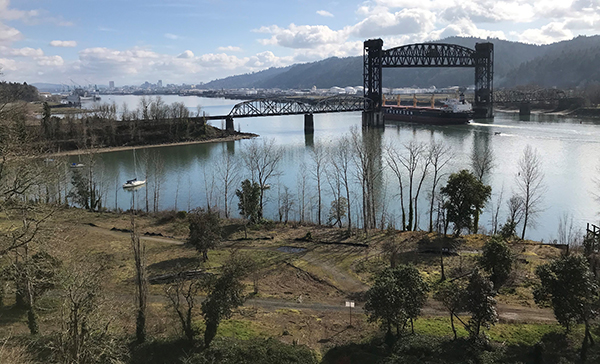Willamette Cove is situated on the east bank of the Willamette River north of the Railroad Bridge in Portland's Cathedral Park neighborhood. Its industrial history dates back to the 1900s, spans 70 years, and has resulted in contamination that remains today in the uplands, riverbanks and adjacent river area. It is not safe to visit the site until cleanup is completed.
Project updates
The Port of Portland and Metro are currently developing design and planning documents in coordination with DEQ to implement the final cleanup plan, called a Record of Decision. The cleanup will address contaminated soil at the site that is currently unsafe for people and wildlife. Careful planning is also required to ensure all work conducted is safe for workers and surrounding community.
In 2022 the Port of Portland and Metro performed a significant amount of sampling within the upland portion of the site with the intent of generating high-quality data to better inform and develop plans to construct the cleanup. Approximately 4,000 soil samples were collected. These samples provide important information about where the contamination is and how much the soil contains.
Using this valuable data the Port of Portland and Metro have prepared a Basis of Design Report which presents their overall approach for implementing the upland cleanup. The draft report is currently being reviewed by DEQ and will be updated to incorporate DEQ comments before a final report is approved.
The basis of design is one of many “design" documents that must be prepared before the cleanup work can begin. As part of the cleanup process for complex projects like Willamette Cove, DEQ reviews a series of design and planning documents to ensure that the cleanup fully restores the site to protective conditions safe for use. Each consecutive design document provides more detail as additional evaluations are completed.
These design and planning documents will detail how much soil will be cleaned up, how the contaminated soil will be handled, transported and disposed of, and how the site will be managed to ensure environmentally protective conditions are maintained into the future. The documents will also include requirements for how the work will be done in a way that is safe for site workers and the community. Project documents will be shared on DEQ's records website and on this page as they become available.
In-water work update
The U.S. Environmental Protection Agency and the Willamette Cove In-water Remedial Design Group (City of Portland, Oregon Department of State Lands and Port of Portland) are working on the Willamette Cove in-water project area, which is part of the Portland Harbor Superfund Site. Learn more about this work and get contact information. The work to clean up the Willamette Cove upland property is being closely coordinated with the work EPA is overseeing to clean up the riverbank, beach and adjoining Willamette River.
DEQ is working with the Port of Portland, Metro and others to clean up contamination at this property, a former industrial site in North Portland along the east bank of the Willamette River. The property comprises approximately 27 acres and approximately 3,000 feet of Willamette River shoreline. Located south of the St. Johns Bridge, adjoining or nearby neighborhoods include Cathedral Park, St. Johns, and University Park.
 1920 photo shows dry dock construction and an example of the extensive infrastructure that was created to support the St. Johns Ship Repair Yard.
1920 photo shows dry dock construction and an example of the extensive infrastructure that was created to support the St. Johns Ship Repair Yard.
Willamette Cove's industrial use dates back to the early 1900s, including a lumber mill, plywood mill, barrel manufacturer and dry dock and ship repair facility. Industrial activities ended by the early 1980s. Metro purchased the property in 1996 and plans to preserve the land primarily as a natural area.
Previous industrial activities resulted in soil contamination. The contamination includes heavy metals, diesel fuel, polychlorinated biphenyls (PCBs) and dioxins. These chemicals pose a risk to human health and the environment. While interim cleanup actions were performed in 2004, 2008, and 2015-2016, soil contamination remains at the property that poses a risk to people and the environment.
 Recent photo shows current site conditions. Plants and animals have reemerged after industrial activities generally ceased in the 1970s. Photo courtesy of Michael Pouncil.
Recent photo shows current site conditions. Plants and animals have reemerged after industrial activities generally ceased in the 1970s. Photo courtesy of Michael Pouncil.
DEQ determined that the proposed remedy, described below, is protective of human health and the environment based on Metro's planned future use of the site. The main elements are:
- Remove all soil above hot spots, or elevated levels of contamination, to protect human health
- Remove all soil with metals above hot spot levels of contamination to protect plants and animals
- Remaining soil contamination will be addressed with caps or covers, as necessary
- Place at least one foot of clean topsoil across the entire upland area
DEQ also incorporated a contingency remedy in the final cleanup plan to provide flexibility as Metro finalizes their vision in developing the property into a nature park. Under the contingency option, the Metro Council voted to remove additional contaminated soil that would have been placed in a consolidation area onsite and transport this soil offsite for disposal at a landfill. Metro is currently developing a masterplan for the future nature park at Willamette Cove. Learn more about Metro's park planning activities.